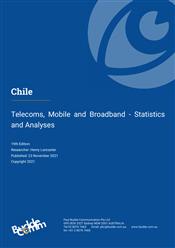Chile Telecoms Market Report
Telecoms, Mobile and Broadband - Statistics and Analyses

5G-suitable frequencies auctioned in Chile
The Chilean market for fixed and mobile telephony is highly competitive and rapidly evolving.
The mobile penetration rate is among the highest in South America. Movistar and Entel remain the market leaders, followed by Claro and WOM. LTE infrastructure is extensive and 5G spectrum auctions which took place in February 2021 are expected to prompt the deployment of 5G networks by the end of the year, following extensive trials held by the MNOs.
Fixed broadband penetration is relatively high for the region, with services among the fastest and least expensive in Latin America. Government initiatives such as the National Fibre Optic project and Fibra Óptica Austral are providing high-capacity connectivity across the country and will further increase fixed-line broadband penetration. There is a strong focus on fibre broadband, with the number of fibre subscribers having increased 61.7% in 2020, year-on-year. Movistar dominates the fibre broadband market, with a 49.7% market share at the end of 2020.
Technological improvements have allowed operators to provide a variety of services via their networks, giving rise to a number of bundled packages at competitive prices, including access to video on demand services which in turn is driving the take-up of fixed-line broadband.
The leading fixed broadband operators are Telefónica Chile, trading as Movistar, VTR Globalcom (VTR), the GTD Group, Entel, Claro, and WOM.
Traditional fixed-line teledensity continues to fall as consumers switch to mobile networks and to fixed broadband for voice and data connectivity.
This report provides an overview of Chile’s telecom sector and regulatory environment, including a range of statistical data and market analyses. It covers the mobile voice and data segments, profiling operators and the key MVNOs, and assessing the development of LTE and 5G infrastructure. It also reviews the fixed-line and fixed-wireless broadband segments, including the status of DSL, cable, and fibre broadband.
BuddeComm notes that the outbreak of the Covid-19 pandemic continues to have a significant impact on production and supply chains globally. Since 2020 the telecoms sector, to various degrees, has experienced a downturn in mobile device production. It was also difficult for network operators to manage workflows when maintaining and upgrading existing infrastructure.
Overall progress towards 5G has been postponed or slowed down in some countries.
On the consumer side, spending on telecoms services and devices is under pressure from the financial effect of large-scale job losses and the consequent restriction on disposable incomes. However, the crucial nature of telecom services, both for general communication as well as a tool for home-working, has offset such pressures. In many markets the net effect will continue to be a steady though reduced increased in subscriber growth.
Although it is challenging to predict and interpret the long-term impacts of the pandemic, these have been acknowledged in the industry forecasts contained in this report.
The report also covers the responses of the telecom operators as well as government agencies and regulators as they react to the crisis to ensure that citizens can continue to make optimum use of telecom services. This can be reflected in subsidy schemes and the promotion of tele-health and tele-education, among other solutions.
Key developments:
- Regulator completes multi-band 5G spectrum auction, agrees to SpaceX providing its Starlink satellite broadband service;
- América Móvil and Liberty Latam agree to combine their respective Chilean businesses VTR and Claro Chile in a 50:50 JV;
- Chile makes progress with its ten-satellite National Satellite System;
- América Móvil approves plan to spin off towers and passive infrastructure in Latin America;
- Telefónica Empresas contracted for the final stretch of the country's National Fibre Optic initiative;
- Regulator contracts for 398 free Wi-Fi zones in different parts of Chile;
- More than 8,300 schools receive free broadband as part of the ‘Connectivity for Education 2030’ project;
- Roaming fees between Argentina and Chile abolished;
- Humboldt submarine cable project to link Chile with New Zealand and Australia;
- Report update includes the regulator's market data update to June 2021, telcos’ financial and operating data to Q3 2021, Telecom Maturity Index charts and analyses, recent market developments.
Companies mentioned in this report
American Tower Corporation, VTR, Caisse de depot et placement du Quebec (CDPQ), Claro Chile, Ericsson, GTD Group (including Telsur, GTD Manquehue, Telesat, Telcoy), Huawei, DirecTV, CTR, CMET/Cable Central, Entel Chile, Grupo GTD, Mundo Pacifico, TuVes HD, Nextel, Nokia, VTR, Virgin Mobile, Falabella, Globalcom, WOM.
Related Reports
- 2019 Latin America - Mobile Network Operators and MVNOs
- Caribbean - Telecoms, Mobile and Broadband - Statistics and Analyses
- Brazil - Telecoms, Mobile and Broadband - Statistics and Analyses
- Guyana - Telecoms, Mobile and Broadband - Statistics and Analyses
- Mexico - Telecoms, Mobile and Broadband - Statistics and Analyses
- El Salvador - Telecoms, Mobile and Broadband - Statistics and Analyses
- Guatemala - Telecoms, Mobile and Broadband - Statistics and Analyses
- Uruguay - Telecoms, Mobile and Broadband - Statistics and Analyses
- Argentina - Telecoms, Mobile and Broadband - Statistics and Analyses
- Ecuador - Telecoms, Mobile and Broadband - Statistics and Analyses
Share this Report
TMT Intelligence
A platform to scale your intelligence tasks
Monitor critical insights with our AI-powered Market Intelligence Platform gathering and analyzing intelligence in real time. With AI trained to spot emerging trends and detect new strategic opportunities, our clients use TMT Intelligence to accelerate their growth.
If you want to know more about it, please see:
Research Methodology
BuddeComm's strategic business reports contain a combination of both primary and secondary research statistics, analyses written by our senior analysts supported by a network of experts, industry contacts and researchers from around the world as well as our own scenario forecasts.
For more details, please see:
More than 4,000 customers from 140 countries utilise BuddeComm Research
Are you interested in BuddeComm's Custom Research Service?
Hot Topics
News & Views
Have the latest telecommunications industry news delivered to your inbox by subscribing to BuddeComm's weekly newsletter.